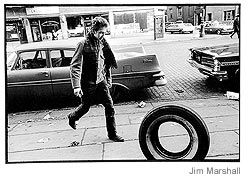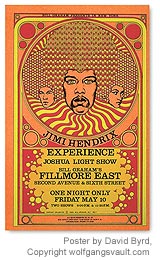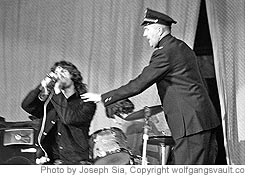Now, this is cool!

WSJ.com - Music Stash Recalls When Rock Was Young
Music Stash Recalls When Rock Was Young Two and a half years ago, a Minneapolis entrepreneur named Bill Sagan spent more than $5 million to buy a treasure trove of rock 'n' roll memorabilia: millions of T-shirts, posters, handbills, photographs, concert tickets and other items from the archives of Bill Graham Presents, the legendary San Francisco rock promoter that virtually invented the modern concert business in the mid 1960s.
But what neither Mr. Sagan nor the seller, Clear Channel Communications Inc., realized at the time was that the archives contained an even more valuable bonus: more than 5,000 live audio and video recordings made between 1966 and 1999, featuring artists varying from the Doors to Nirvana. The recordings were made at rock concerts that the late Mr. Graham ran or promoted. They were uncataloged and collecting dust when Mr. Sagan acquired the archive...
The performances, many of which are professionally recorded and extremely high quality, amount to a sweeping, unheard history of rock during its seminal years and beyond. The archives include performances by artists including Bob Dylan, Bob Marley, Pink Floyd, the Who, Tom Petty, Stevie Wonder, the Mahavishnu Orchestra, Emmylou Harris, Aretha Franklin and Tracy Chapman, all of whom played shows put on by Mr. Graham. The are videotapes of early performances by Crosby Stills Nash & Young and from 1978, the Sex Pistols' last show for nearly 20 years, before their reunion in 1996.Though some of the recordings have leaked as bootlegs over the years, they contain some revealing moments that may surprise fans. For example, a recording taken from Led Zeppelin's first U.S. tour, in 1969 -- when the band was opening for Country Joe & the Fish -- finds lead singer Robert Plant displaying little of the rock-god swagger that would eventually become his trademark. Instead, he makes nervous small talk to the audience as guitarist Jimmy Page changes a broken string.


I wonder how long the negotiations between record labels, artists, and Wolfgangsvault are going to take?
When, or even if, the general public will ever hear or see many of these recordings is unclear, however.The recordings were made legally; Mr. Sagan has a filing cabinet filled with documentation to prove it. But selling them will require various permissions and revenue-sharing deals -- not only with the artists themselves, but often, too, with whatever record label they were signed to at the time of the show, or its corporate successor. In the case of dead performers, permission is required from their families or other heirs.
Mr. Sagan's employees have already digitized more than 1,000 audio recordings and sent them to engineers to have the sound quality cleaned up. Now they are in the process of seeking clearances to release the music. Mr. Sagan says he is in active discussions with two major record labels, and believes he is close to a deal for at least some music with one of them, although he declines to name either.“Is it easy?” he asks. “No. But in some cases they're excited as hell they might be able to make some money of old bands.”
and nobody really wants to hear 15 hours of Eddie Money, or Jefferson Starship for that matter...
Even with clearances, much of the material in the archives is simply not up to snuff for commercial release. “I don't think a large percentage of it will end up on CD, or in any monetized form,” says Gavin Haag, who oversees the company's music-licensing efforts. For instance, he adds, there may never be an appetite for dozens of separate concerts by acts like Eddie Money.
